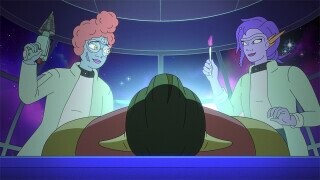Laughter May Be the Best Medicine, But That Has Nothing to Do With ‘The Second Best Hospital in the Galaxy’

Last month, I used this space to complain about the recent tendency for adult animation shows to go over-the-top with quirky premises. Little did I know an adult animation show was barreling toward me that’s so weird it makes Grimsburg look like The Office. I wish the creators of The Second Best Hospital in the Galaxy understood that just because a show is set in space doesn’t mean it needs to alienate its audience.
Best friends and roommates for many years, Drs. Klak (voice of Keke Palmer) and Sleech (Stephanie Hsu) are employed at the titular institution. I guess there’s a huge dropoff in quality after Nebula General, the first best hospital in the galaxy, because I was watching pretty closely, and I don’t think the titular institution ever gets the honor of a proper name. In the series premiere, Sleech and Klak meet a patient named Glurg (Lennon Parham). She has a large lump on her head, but it’s not exactly an affliction at the moment: Glurg has a history of severe anxiety, and anxiety is exactly what this parasite eats, keeping Glurg at an even keel. Alas, if Klak and Sleech remove it, they believe Glurg will die; if they don’t, her head will explode. On top of that, Klak also struggles with anxiety — from a young age, she’s been the subject of pop-science books by her therapist mother, Dr. K (Tracee Ellis Ross) — so she’s intrigued by the prospect of studying the parasite and possibly making it available on a large scale as an anxiety treatment.
Also: Klak has three eyes, has fins on various parts of her face and body and sleeps with her face in a fish bowl; Sleech has a prominent brow ridge, horns growing out of her ears and a tail; Glurg resembles a manatee. The doctors’ colleagues include Dr. Plowp (Kieran Culkin), a large yellow bird with the power to experience patients’ emotions; Dr. Vlam (Maya Rudolph, also an executive producer), who’s a robot; and Nurse Tup (Rudolph’s fellow EP Natasha Lyonne), who kind of looks like a pink dragon with candy floss hair.
Don't Miss
Naturally, I have watched and enjoyed pop culture featuring non-human characters before, including in the adult animation genre. Futurama, for example, features multiple alien and robot characters, humanoid and otherwise; nearly every episode involves travel to at least one other planet. But Futurama works because, amid all the entirely invented worlds and races, we are grounded with recognizably human characters — particularly Fry (Billy West), our POV character, who has been transported from our era to the 31st century and thus can ask expository questions the viewer might have as well. Hospital not only drops us into an unfamiliar world, but also, every choice seems intended to maximize weirdness for weirdness’s sake.
You want to invent alien characters? Call them Claire and Selena (or whatever) so that anyone watching doesn’t have to keep IMDb open the whole time they’re watching just to keep everyone straight. You want to make your setting strange? You accomplish that by using absolutely no human character models; you don’t have to invent numbers (e.g., “On a scale of throm to thrisk…”) — particularly not when, in the same scene, we see 33 and 34 next to patient rooms, and not when all the characters are speaking English! Don’t disorient the viewer unless you have a reason!
Arguably, series creator Cirocco Dunlap, whose diverse CV includes writing gigs on Late Night with Jimmy Fallon, Russian Doll and the kids’ show Waffles + Mochi, did create humanoid characters with Star Trek-ian prosthetics drawn on, but other than the deep and sincere friendship between the leads, the recognizably human-ish themes through the season are all huge bummers. Klak’s anxiety is tough enough to watch on its own; seeing how her opportunistic and seemingly uncaring mother has built her career on it makes it even darker. Fear of commitment is a topic countless sitcoms have already explored before we find out Sleech suffers from it, and the ways it makes her sabotage relationships, causing pain to perfectly good partners, are extremely predictable. Even in this fantastical world, medicine is explicitly a for-profit enterprise — Nebula General is operated by a snack company called Uniyum — but Dunlap seems not to have much to say about that until the season is practically over and the idea of ethics in pharmaceutical research briefly takes center stage.
When the titular setting and the work that takes place within are among the few aspects of the show that are at all legible for its (presumably mostly) human audience, it would be nice if more of it were pointed social commentary, or fun, or ideally both. When I tell you the closest you get is “The Curse of the Orlosh,” Episode Four’s titular STI — which remakes the infected so that they physically resemble their last partners — I think you will appreciate what a drag this show can be.
Many talented people I’ve enjoyed elsewhere signed on to do this show: In addition to the voice stars named above, there’s Sam Smith (as Dr. Azel, the star surgeon at Nebula General), Abbi Jacobson and John Waters, among many others. I don’t know why. The Second Best Hospital in the Galaxy is not second best in any other category it belongs to. In fact, on a scale of throm to thrisk, it’s a zero.